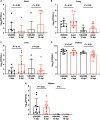Staphylococcus aureus Peptide Methionine Sulfoxide Reductases Protect from Human Whole-Blood Killing
- PMID: 34001560
- PMCID: PMC8281210
- DOI: 10.1128/IAI.00146-21
Staphylococcus aureus Peptide Methionine Sulfoxide Reductases Protect from Human Whole-Blood Killing
Abstract
The generation of oxidative stress is a host strategy used to control Staphylococcus aureus infections. Sulfur-containing amino acids, cysteine and methionine, are particularly susceptible to oxidation because of the inherent reactivity of sulfur. Due to the constant threat of protein oxidation, many systems evolved to protect S. aureus from protein oxidation or to repair protein oxidation after it occurs. The S. aureus peptide methionine sulfoxide reductase (Msr) system reduces methionine sulfoxide to methionine. Staphylococci have four Msr enzymes, which all perform this reaction. Deleting all four msr genes in USA300 LAC (Δmsr) sensitizes S. aureus to hypochlorous acid (HOCl) killing; however, the Δmsr strain does not exhibit increased sensitivity to H2O2 stress or superoxide anion stress generated by paraquat or pyocyanin. Consistent with increased susceptibility to HOCl killing, the Δmsr strain is slower to recover following coculture with both murine and human neutrophils than USA300 wild type. The Δmsr strain is attenuated for dissemination to the spleen following murine intraperitoneal infection and exhibits reduced bacterial burdens in a murine skin infection model. Notably, no differences in bacterial burdens were observed in any organ following murine intravenous infection. Consistent with these observations, USA300 wild-type and Δmsr strains have similar survival phenotypes when incubated with murine whole blood. However, the Δmsr strain is killed more efficiently by human whole blood. These findings indicate that species-specific immune cell composition of the blood may influence the importance of Msr enzymes during S. aureus infection of the human host.
Keywords: MRSA; Staphylococcus aureus; methionine sulfoxide; methionine sulfoxide reductases; oxidative stress; pathogenesis.
Figures






References
-
- Klevens RM, Morrison MA, Nadle J, Petit S, Gershman K, Ray S, Harrison LH, Lynfield R, Dumyati G, Townes JM, Craig AS, Zell ER, Fosheim GE, McDougal LK, Carey RB, Fridkin SK, Active Bacterial Core Surveillance MRSA Investigators . 2007. Invasive methicillin-resistant Staphylococcus aureus infections in the United States. JAMA 298:1763–1771. 10.1001/jama.298.15.1763. - DOI - PubMed
-
- CDC. 2019. Antibiotic resistance threats in the United States. https://www.cdc.gov/DrugResistance/Biggest-Threats.html. Accessed 1 March 2021.
Publication types
MeSH terms
Substances
Grants and funding
LinkOut - more resources
Full Text Sources
Other Literature Sources
Medical

